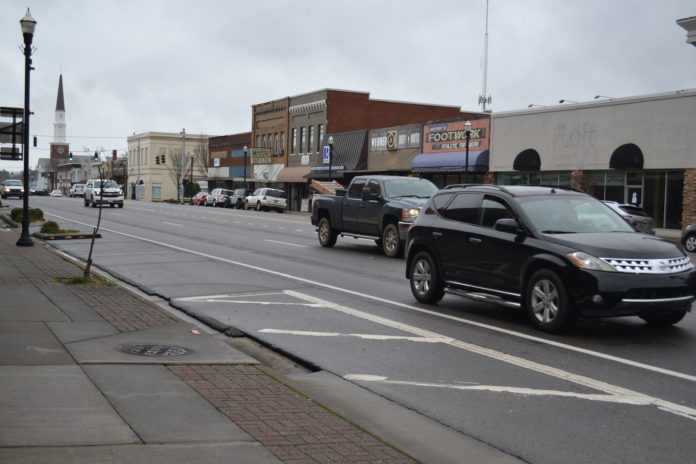
CULLMAN, Ala. – After 2018 proved to be the worst year ever for traffic fatalities in the city of Cullman, the Cullman Police Department (CPD) is relieved to report a drop of more than 50% in 2019, even though the overall number of wrecks dipped only slightly. Still, the department’s Traffic Homicide officers are not satisfied, saying that even one would be one too many.
2019 by the numbers
Note: These numbers reflect only incidents within Cullman’s city limits, and do not include other locations in the county.
Total traffic crashes decreased a modest 2.4%, but at least moved in the right direction.
- 2018 – 1,006
- 2019 – 982
Traffic fatalities dropped by more one half.
- 2018 – Seven fatalities
- 2019 – Three fatalities
CPD Traffic Homicide Sgt. Joey Duncan was pleased to see the sharp decline, but noted, “You know we want that number to be zero.”
Top 10 causes of wrecks
- Following too close – 237 incidents. Duncan had more to say on this. See below.
- Improper lane change/use – 97 incidents
- Failure to yield right of way from Stop sign – 88 incidents
- Running traffic signal – 72 incidents
- Failure to yield right of way while making left or U-turn – 57 incidents
- Misjudging stopping distance – 43 incidents
- Failure to yield right of way from driveway – 41 incidents
- Improper backing – 35 incidents
- Failure to yield right of way from traffic signal – 26 incidents
- A three-way tie occurred for number 10:
-
- Driving too fast for road conditions – 25 incidents
- Distraction inside vehicle other than electronic device or passenger – 25 incidents
- Distraction outside vehicle other than fallen object – 25 incidents
While the number one cause of wrecks in general was following too close, the top cause of fatalities was drivers running red lights, as it was in 2018.
Distracted driving
In the total list of official statistics, distracted driving accounted for 75 wrecks, but Duncan was convinced that distractions actually contributed to a substantially higher number of incidents, especially the number one cause, following too close. To him, the issue is not so much drivers following too close by habit, but ending up too close when they do not notice what is happening on the road right in front of them.
Said Duncan, “I don’t think it’s necessarily a tailgating issue we’re having problems with. I think it’s just the distraction; it’s so easy for people to be distracted by something these days, whether it’s paying attention to the restaurant that’s on the left side, you know, and they’re not focused on driving; they’re looking out the left side at what’s going on. People are just not watching the road when they drive, and that’s why we’re having so much-such a high number-of following too close. I really believe it.”
See more on the issue of distracted driving in the closing section of this story.
Where are wrecks happening?
In 2019, according to Duncan, “Most of our vehicle crashes, the majority of them are occurring in a 30 mile per hour speed zone, which is what U.S. Highway 31 is (through downtown Cullman).”
Duncan plotted all of 2019’s incidents on a digital city map. The highest concentrations of crashes occurred in the vicinity of the U.S. Highway 31/U.S. Highway 278 intersection (and for several blocks in all four directions, especially around the Highway 31/Main Avenue intersection), and in the vicinity of the Highway 31/Alabama Highway 157 intersection. Smaller concentrations occurred:
- Along the Highway 157 corridor from its intersection with St. Joseph Drive Northwest to the Interstate 65 interchange
- Along Highway 157 near the Childhaven Road intersection, including a short distance on Highway 157 in both directions
- At the intersection of Highway 157 and Eva Road
- Around the Highway 31/Cherokee Avenue intersection and for several blocks down through the Cherokee Avenue retail corridor
- Along Highway 31 near the Cullman County Fairgrounds/Sportsman Lake Park
- At the intersection of Alabama Highway 69 and Highway 157
- Near the Highway 278/Interstate 65 interchange
From 2010 to 2019
Reviewing statistics including property damage, injuries from minor to serious and fatalities, the CPD presented these numbers tracking incidents from the last 10 years, showing a fairly steady rise in incidents until last year.
- 2010 – 746 total incidents, one fatality
- 2011 – 709 total incidents, five fatalities
- 2012 – 738 total incidents, no reported fatalities
- 2013 – 758 total incidents, one fatality
- 2014 – 790 total incidents, two fatalities
- 2015 – 916 total incidents, four fatalities
- 2016 – 965 total incidents, two fatalities
- 2017 – 970 total incidents, no reported fatalities
- 2018 – 1006 total incidents, seven fatalities
- 2019 – 982 total incidents, three fatalities
Turning the tide: CPD creates Traffic Homicide Investigation unit
In 2017, the CPD sent Duncan and Officer Jonathan England for specialized training in traffic homicide investigation in order to lay the foundation for a specialized and dedicated Traffic Homicide Unit. In wrecks involving a fatality, the investigators can work up a 300-page package of incident details as specific as the depth of tread on the tires of involved vehicles. In less than two years, their new skill set has produced five indictments for vehicular homicide.
Said Duncan, “The (Cullman County) DA’s office loves it. I mean, they’re getting everything they need for prosecution.”
The two-man unit, working in conjunction with patrol officers, also studied the most common areas of the city for wrecks, and then went into those areas to stop speeders and other offenders. If reading about the dangers of unsafe driving or tips for keeping things safe did not interest drivers, maybe reading traffic tickets would.
Asked what he thought contributed to the downturn, Duncan told The Tribune, “I think a lot of the public awareness that we’re doing here at the police department by using the media outlets, using social media. Also, we have really stepped up our traffic enforcement, particularly in areas where fatality crashes are occurring. We are designating officers in specialties of traffic enforcement in those areas, and we’re going after what causes the fatalities.”
Of the intersections where drivers commonly run red lights, Duncan said, “We’re getting officers in that area to really monitor red lights and also speed, because, you know, speed necessarily doesn’t cause the wrecks, but it does intensify the injury. We know that.”
The CPD hopes to expand its Traffic Homicide Unit in the future, to provide 24/7 coverage around town.
Interesting details
The 2019 statistics showed that men were slightly more likely than women to get into wrecks: 491 incidents involved men, 434 involved women.
Chevrolet vehicles were most likely to be involved in wrecks (192 incidents), followed by Fords (145). Duncan pointed out that the numbers of vehicles of any brand involved in wrecks was roughly in line with the number of vehicles of that brand on the road in the area; that is to say that Chevys are more likely to get in wrecks because there are more Chevys on the road, not because of any issue of vehicle quality or safety.
Thursday was the worst day to be on the road in Cullman, with the highest number of wrecks, though Friday was close behind. Sunday was the safest day by a long shot.
The largest number of wrecks occurred in 30 mile per hour speed zones, especially along Highway 31 through the downtown corridor. Zones of 45 and 55 miles per hour came in second and third.
What should drivers do?
The formula for avoiding the most common collisions in Cullman seems fairly simple:
- Keep a safe distance between your vehicle and those ahead of you.
- Pay close attention to everything around you, especially in traffic.
- Do not run red lights.
- Remember that, as careful as you might be to avoid causing an accident, you want to be just as careful to avoid becoming a victim. If you avoid running a red light, someone else might not.
England said in a previous interview, “When the light is green, pay attention. Look both ways, make sure that nobody’s coming through the intersection. Never rely on somebody else.”
Avoid distractions: turn off electronic devices
The CPD’s observations of drivers not paying attention to what they are doing or to what is happening around them echo growing concerns about distracted driving across the nation, with electronic devices being cited as one of the biggest culprits. Almost everyone has seen ads, commercials or online videos about the dangers of driving while texting, reading or even talking on a hand-held cell phone. The National Safety Council (NSC) has published studies, though, indicating that even the new generation of hands-free technology does not help nearly as much as people think.
In its 2012 publication “Understanding the Distracted Brain,” the NSC stated:
Multitasking is valued in today’s culture, and our drive for increased productivity makes it tempting to use cell phones while behind the wheel. People often think they are effectively accomplishing two tasks at the same time. And yes, they may complete a phone conversation while they drive and arrive at their destination without incident, thus accomplishing two tasks during the same time frame. However, there are two truths to this common belief.
- People actually did not “multitask.”
- People did not accomplish both tasks with optimal focus and effectiveness.
Multitasking is a myth. Human brains do not perform two tasks at the same time. Instead, the brain handles tasks sequentially, switching between one task and another. Brains can juggle tasks very rapidly, which leads us to erroneously believe we are doing two tasks at the same time. In reality, the brain is switching attention between tasks – performing only one task at a time.
The study focused on cell phone use, which the NSC considers to be among the biggest safety issues for drivers, including those who use hands-free technology. The report continued:
Vision is the most important sense for safe driving. Yet, drivers using hands-free phones (and those using handheld phones) have a tendency to “look at” but not “see” objects. Estimates indicate that drivers using cell phones look but fail to see up to 50 percent of the information in their driving environment. Distracted drivers experience what researchers call inattention blindness, similar to that of tunnel vision. Drivers are looking out the windshield, but they do not process everything in the roadway environment that they must know to effectively monitor their surroundings, seek and identify potential hazards, and respond to unexpected situations.
Today there are more than 320 million wireless connections in the U.S. And although public sentiment appears to be turning against cell phone use while driving, many admit they regularly talk or text while driving. The National Highway Traffic Safety Administration estimates that nine percent of all drivers at any given time are using cell phones, and the National Safety Council estimates about one in four motor vehicle crashes involve cell phone use at the time of the crash.
Cell phone distracted driving has become a serious public health threat. A few states have passed legislation making it illegal to use a handheld cell phone while driving. These laws give the false impression that using a hands-free phone is safe.
The NSC’s study indicated that drivers carrying on cell phone conversations, even hands-free, tended to suffer:
- Inattention blindness – not seeing things right in front of them, and especially to the sides. Eye movement studies showed that drivers talking on hands-free phones tended to focus their eyes on a much smaller field right in front of their vehicles and not keep an active watch on other areas within their field of vision. Areas outside the talking drivers’ narrow focus include common locations of Stop signs, traffic lights, oncoming side road traffic at intersections, and points from which pedestrians are likely to step out into the street.
- Slower response time and reaction time – In one driving simulator study, participants actively engaged in cell phone conversations had slower reaction and response times than participants with a .08 blood alcohol concentration, legally drunk in Alabama.
- Problems staying in their lanes
The NSC study concluded that a person talking on a cell phone while driving is four times more likely to be involved in a crash than a person not using a phone, whether the device is hand-held or hands-free.
Copyright 2020 Humble Roots, LLC. All Rights Reserved.





















